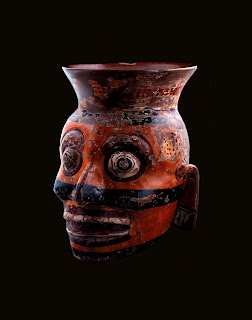The Aztecs
May 30 - October 25, 2015
Pointe-à-Callière Museum (PAC) is presenting a major international exhibition, The Aztecs, People of the Sun. Visitors have a unique opportunity to learn about the people who founded the amazing city of Tenochtitlan, capital of the Aztec Empire and the site where Mexico City was built after the Spanish Conquest in 1521. The exhibition documents at length the founding of Tenochtitlan, people's daily lives, and their everyday and ritual objects.
The exhibition also focuses on two Aztec calendars, the Templo Mayor, and also on the religious human sacrifices. It looks at many themes in Aztec's rich history: the Aztecs’ migration, guided by their god Huitzilopochtli; the founding of Tenochtitlan; the remarkable urban planning and land use development in this “Venice of Mexico”; the Aztec art of war and the tribute paid to conquerors by the conquered peoples; and their agricultural techniques and chinampas, the ingenious floating gardens that made the city self-sufficient.
The exhibition also looks at the organization of Aztec society and its different classes. It elaborates on the role of women, education and the administration of justice. Aztec writing, the famous codices - manuscripts made up of glyphs or pictograms illustrating the spoken language - are also examined. Religion, essential and omnipresent in Aztec society, is also brought into focus, along with various deities, rituals and believes.
The exhibition was produced in collaboration with the Mexican National Council for
Culture and the Arts – National Institute of Anthropology and History (INAH). It showcases
some 265 items from 16 Mexican museums, including the Templo Mayor Museum, an
archaeological site museum like Pointe-à-Callière itself, and the Mexican
National Museum of Anthropology.
A great variety of objects is on display, both spectacular and moving. There are masks and statues, gold jewellery, figurines of women,
children and animals, stamps for creating patterns on fabric and skin, chests, boxes for offerings, vases and ceramics, sculptures and objects relating to the sacrifices which it was believed were required to keep the Sun on
its daily journey. They all reflect
the mysteries surrounding the Aztec culture and people.
The exhibition closes with a description of the Spanish conquest, the fall of the Aztec Empire, and the legacy of the Aztecs today.
Hover your mouse over images to see credits.
For more information, visit the Pac Museum website
http://www.pacmusee.qc.ca/en






















































